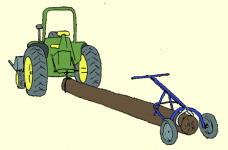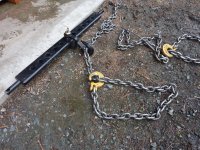RoyJackson
Rest in Peace
- Joined
- Nov 17, 2001
- Messages
- 24,646
- Location
- Bethel, Vermont
- Tractor
- John Deere 4052R Cab,, Deere 855D UTV, Z920A Zero Turn Mower and assorted implements
I'd suggest chains on the rear tires and as much weight as you can get in the loader's bucket. Personally, I would not depend on the differential lock...once traction is lost on one tire, a differential lock isn't going to guarantee adequate traction on the other tire...both might spin. Then low gear, seat belt on and going up slow and steady.
Now, if I'm looking at those pictures right...it doesn't look like a steady slope...seems to be a bit of a rise, then pretty steep at the end...is then correct? If so, I use the tractor to drag the logs to the beginning of the steeper section, then winch them up the steep part from above.
To me, the worst scenario would be getting halfway up that steep section and getting stuck (log digging in, for example) Logging winches lift the end(s) of the log up a few inches to prevent this. Your 3PH might be able to lift the end, but that will raise your C of G...so, again, front ballast is essential.
Your 1700 weighs about 2300 lbs plus the loader...figure about 3000 lbs total. Any of those logs that look to weigh more then 1000 lbs...might be worth cutting them in half....make it easier to skid them up that slope.
Another suggestion is have someone else there...just in case.
Now, if I'm looking at those pictures right...it doesn't look like a steady slope...seems to be a bit of a rise, then pretty steep at the end...is then correct? If so, I use the tractor to drag the logs to the beginning of the steeper section, then winch them up the steep part from above.
To me, the worst scenario would be getting halfway up that steep section and getting stuck (log digging in, for example) Logging winches lift the end(s) of the log up a few inches to prevent this. Your 3PH might be able to lift the end, but that will raise your C of G...so, again, front ballast is essential.
Your 1700 weighs about 2300 lbs plus the loader...figure about 3000 lbs total. Any of those logs that look to weigh more then 1000 lbs...might be worth cutting them in half....make it easier to skid them up that slope.
Another suggestion is have someone else there...just in case.


